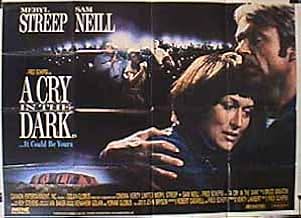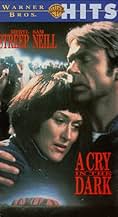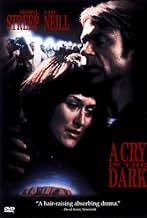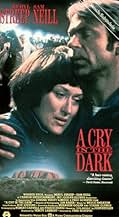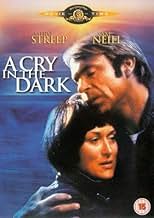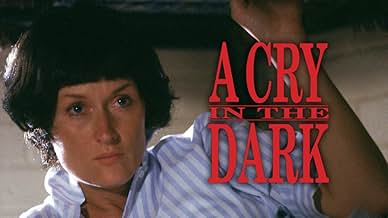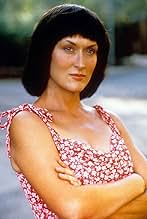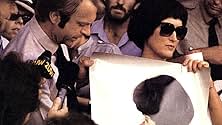A mother whose child was killed in a dingo attack in the Australian Outback fights to prove her innocence when she is accused of murder.A mother whose child was killed in a dingo attack in the Australian Outback fights to prove her innocence when she is accused of murder.A mother whose child was killed in a dingo attack in the Australian Outback fights to prove her innocence when she is accused of murder.
- Director
- Writers
- Stars
- Nominated for 1 Oscar
- 8 wins & 13 nominations total
Charles 'Bud' Tingwell
- Justice Muirhead
- (as Charles Tingwell)
- Director
- Writers
- All cast & crew
- Production, box office & more at IMDbPro
Featured reviews
Meryl Streep is such a genius. Well, at least as an actress. I know she's been made fun of for doing a lot of roles with accents, but she nails the accent every time. Her performance as Lindy Chamberlain was inspiring. Mrs. Chamberlain, as portrayed here, was not particularly likable, nor all that smart. But that just makes Streep's work all the more remarkable. I think she is worth all 10 or so of her Oscar nominations. About the film, well, there were a couple of interesting things. I don't know much about Australia, but the theme of religious bigotry among the general public played a big part in the story. I had largely missed this when I first saw the film some years ago, but it came through loud and clear yesterday. And it seems the Australian press is just as accomplished at misery-inducing pursuit and overkill as their American colleagues. A pretty good film. A bit different. Grade: B
Common sense tells us that "seeing is believing." Experience tells us that, when motivation is strong enough, it's the other way around -- "believing is seeing." Under pressure from the press and from public opinion, criminalists see blood where there is no blood. Forensic pathologists who have never see a dingo claim an absence of dingo teeth marks. Investigators see an arterial blood spray where there is nothing but a sound-deadening compound.
The case took place at a time when another of those episodes of collective hysteria was sweeping the English-speaking world. Satanic worshippers lurked in the most unlikely place and preschools were filled with pedophiles. Smokers endangered our health by subjecting us to whiffs of the burning weed. We seem to need an expression for our collective hatred. There's even evidence from gerontological studies that angry people tend to outlive more pacific individuals -- an effect the authors attributed to "the necessary enemy." Maybe now, after the resurgence of Islamic fundamentalism, we'll have more palpable enemies than will o' the wisps.
The Chamberlains were caught up in that wave of collective hatred. The case must have been a dramatic one -- wild dog eats baby! One can imagine the headlines, the earnest discussions, the fixed conclusions based on presumptions. Lindy Chamberlain certainly did nothing to discourage the calumny heaped upon her. She wasn't very good at playing the victim, in contrast to, say, the Menendez brothers who slaughtered their parents, then wept on the stand while describing how abused they were, and wound up with a mistrial. And not nearly as good as Susan Smith, the woman in the unlikely town of Union, South Carolina, who drowned her two children and sobbed openly on TV while begging the mythical black kidnapper not to harm them.
Well, after all, occupying the role of victim is an acquired skill and some have acquired less of it than others. (Mersault, in Camus' "The Stranger.") Lindy Chamberlain, as expertly played here my Meryl Streep, a phenomenally talented technical actress, is not a likable person. She matter-of-factly whines on, complaining about things in a sing-song voice, punctuated by occasional outbursts of anger. She needed some coaching from the Menendez' on how to engage the jury's sympathy. And she LOOKS wrong too. She should be small and vulnerable, instead of lumpy. And she seems to have gone out of her way to look ill-groomed. Streep, properly glamorized, is a beautiful and intelligent-looking woman. As Lindy Chamberlain her eyebrows are plucked and then painted back in as mere smudges by the makeup department. Her black hair (which should have been blonde) was probably meant to be in a style called page boy (is that right?) but comes out looking more like a Nazi helmet. Streep must have put on weight for the role. Her arms and breasts are flabby and her neck seems the size of a telephone pole, reducing her lips to a tiny pink orifice in the middle of the vast featureless plane of her face. She's as unsympathetic as all get out and human nature being what it is, people are likely to get confused about the difference between being dislikable and being guilty of murder.
Sam Neill is far more sympathetic a character but, where Streep is arrogant, he's sensitive, muddled, and weak. He's completely discombobulated by the prosecution's series of questions: "Did she say she saw anything in the dingo's mouth? Did she say she didn't see anything in the dingo's mouth? Did she tell you she saw NOTHING in the dingo's mouth?" Confused, he answers that, yes, she told him she saw the dingo come out with the baby in her mouth.
Reminds me of an interrogation from "Catch-22", something like this. Superior officer to subordinate: "When did you say we were a bunch of fools?" Subordinate: "I never said you were fools." Superior: "Now you're telling me when you DIDN'T say it. I'm asking you when you DID say we were a bunch of fools." Subordinate: "I ALWAYS never say you were a bunch of fools."
It's a fast-paced movie. If there were any dissolves I missed them. The story comes to us in pointed scenes of the Chamberlains together, intercut with snippets of public reaction to the spectacle. But the movie, for all the tragedy inherent in the story, isn't gripping. It not only has no hero or heroine, there's no one who's particularly likable. Neill suffers in silence and Streep has almost done too good a job alienating us from her character and her anguish. But overall, whatever it lacks in emotional impact it more than makes up for in its instructive quality. And of course our sympathies are with the real-life Chamberlains who were put through an immeasurable ordeal. The press and the gossipy, half-hysterical public may be easy targets, but they're very real threats to our collective common sense.
The case took place at a time when another of those episodes of collective hysteria was sweeping the English-speaking world. Satanic worshippers lurked in the most unlikely place and preschools were filled with pedophiles. Smokers endangered our health by subjecting us to whiffs of the burning weed. We seem to need an expression for our collective hatred. There's even evidence from gerontological studies that angry people tend to outlive more pacific individuals -- an effect the authors attributed to "the necessary enemy." Maybe now, after the resurgence of Islamic fundamentalism, we'll have more palpable enemies than will o' the wisps.
The Chamberlains were caught up in that wave of collective hatred. The case must have been a dramatic one -- wild dog eats baby! One can imagine the headlines, the earnest discussions, the fixed conclusions based on presumptions. Lindy Chamberlain certainly did nothing to discourage the calumny heaped upon her. She wasn't very good at playing the victim, in contrast to, say, the Menendez brothers who slaughtered their parents, then wept on the stand while describing how abused they were, and wound up with a mistrial. And not nearly as good as Susan Smith, the woman in the unlikely town of Union, South Carolina, who drowned her two children and sobbed openly on TV while begging the mythical black kidnapper not to harm them.
Well, after all, occupying the role of victim is an acquired skill and some have acquired less of it than others. (Mersault, in Camus' "The Stranger.") Lindy Chamberlain, as expertly played here my Meryl Streep, a phenomenally talented technical actress, is not a likable person. She matter-of-factly whines on, complaining about things in a sing-song voice, punctuated by occasional outbursts of anger. She needed some coaching from the Menendez' on how to engage the jury's sympathy. And she LOOKS wrong too. She should be small and vulnerable, instead of lumpy. And she seems to have gone out of her way to look ill-groomed. Streep, properly glamorized, is a beautiful and intelligent-looking woman. As Lindy Chamberlain her eyebrows are plucked and then painted back in as mere smudges by the makeup department. Her black hair (which should have been blonde) was probably meant to be in a style called page boy (is that right?) but comes out looking more like a Nazi helmet. Streep must have put on weight for the role. Her arms and breasts are flabby and her neck seems the size of a telephone pole, reducing her lips to a tiny pink orifice in the middle of the vast featureless plane of her face. She's as unsympathetic as all get out and human nature being what it is, people are likely to get confused about the difference between being dislikable and being guilty of murder.
Sam Neill is far more sympathetic a character but, where Streep is arrogant, he's sensitive, muddled, and weak. He's completely discombobulated by the prosecution's series of questions: "Did she say she saw anything in the dingo's mouth? Did she say she didn't see anything in the dingo's mouth? Did she tell you she saw NOTHING in the dingo's mouth?" Confused, he answers that, yes, she told him she saw the dingo come out with the baby in her mouth.
Reminds me of an interrogation from "Catch-22", something like this. Superior officer to subordinate: "When did you say we were a bunch of fools?" Subordinate: "I never said you were fools." Superior: "Now you're telling me when you DIDN'T say it. I'm asking you when you DID say we were a bunch of fools." Subordinate: "I ALWAYS never say you were a bunch of fools."
It's a fast-paced movie. If there were any dissolves I missed them. The story comes to us in pointed scenes of the Chamberlains together, intercut with snippets of public reaction to the spectacle. But the movie, for all the tragedy inherent in the story, isn't gripping. It not only has no hero or heroine, there's no one who's particularly likable. Neill suffers in silence and Streep has almost done too good a job alienating us from her character and her anguish. But overall, whatever it lacks in emotional impact it more than makes up for in its instructive quality. And of course our sympathies are with the real-life Chamberlains who were put through an immeasurable ordeal. The press and the gossipy, half-hysterical public may be easy targets, but they're very real threats to our collective common sense.
The facts in the case of an Australian couple persecuted by a headline-hungry press should be familiar to viewers of the CBS news show 60 Minutes, which aired the story (not coincidentally) just before this film was released. Both versions recount the disappearance during a weekend camping trip of Lindy and Michael Chamberlain's infant daughter, and the subsequent three-ring media circus which led to wild (and totally fabricated) accusations of cult fanaticism and ritual sacrifices, and eventually to a murder conviction for the bereaved mother. But the big screen dramatization has more in mind than just a strong reprimand for misguided journalism ethics. The reporters covering the case are shown to be more ferocious than the wild dingo dog claimed by the Chamberlain's to have killed their child, but the screenplay wisely implicates public opinion as well, which condemned Lindy Chamberlain to prison for not having a telegenic personality (the same trait might also lose her sympathy with moviegoers, despite another challenging performance by Meryl Streep). Director Fred Schepisi presents the story as a straightforward, undemonstrative docudrama, letting the cold-blooded courtroom drama speak for itself, with a pair of excellent actors (Streep and Sam Neill) taking up the slack.
If there is any Australian that I feel sorrier for, it would have to be Lindy Chamberlain. Her compelling story is one of the more famous court cases in Australian history. Also known as A cry in the dark', Evil Angel' shows how divided the Australian public really were towards this case and how the media can manipulate a story, by favouring just one side of a story that they believe is the whole truth. When I hear the cry The dingo's got my baby', it brings back memories from along time ago.
During a camping trip, an infant disappears from her family's tent. When the child's mother spies a dingo nearby, authorities launch a frantic search, but all they find is a torn, bloodied garment. The press, distressed by the mother's seeming "lack of emotion", and suspicious of her religious beliefs, begin to accuse her of murdering the baby. The sentiment against her begins to grow, and soon the whole continent is talking about the case. Despite the lack of evidence, the woman is imprisoned; although investigators eventually re-examine her story, the damage is done: the innocent mother's relationship with her husband has been irreparably destroyed. This is the documentary style film adaptation of the true story of Lindy and Michael Chamberlain.
This film has some truly amazing performance in it. Meryl Streep is a wonderful actress, but in this film she does so much that you just have to like. She really becomes Lindy' and embodies what she actually went through. I remember reading that Streep had to have speaking classes, so she could sound Australian', which she does very well. But it is her persona I like the most. Streep performance as Chamberlain is so flawless, as she shows no emotion when she is going in and out of court, which is what the real Lindy Chamberlain did. It is understandable that the general public would think that Lindy is guilty of murder, which is again testament to Streep's masterful performance. However in court Lindy is visibly upset, when she has to recall the night a dingo took her baby.
The other performance which is most noteworthy is that of Sam Neill. While Neill has gone on to do many big performances in Hollywood blockbusters such as Jurassic Park' and the Aussie favourite The Dish', this is one film I continue to remember him from. I like how we see that Michael is visibly distressed by the whole court case scenario, with him stumbling through the interrogation when he is on the stand. It is also most taxing on the couple's personal life, with Michael the first one to crack.
Yet there are some famous Australian cameos from many actors in Evil Angel'. Look at these for names; Maurie Fields, Charles Bud' Tingwell, John Howard, Frankie J. Holden, Mark Little, Mark Mitchell, Glenn Robbins and Kym Gyngell. All of them are well known personalities in Australian TV, and it is of great significance to this story to have such great fame among the cast of this film.
Director/Screenwriter of Evil Angel' Fred Schepisi does justice to this story in many ways. Firstly, Schepisi and co screenwriter Robert Caswell stuck very close to the story written by John Bryson. Then Schepisi directs this film in quite a unique way. He points the story in many ways, showing the Chamberlain's in one shot, then to the media, then to the general public. This amount of change gives the film great variety, which is good. If it was fixated with just the Chamberlains, this movie could have had major problems.
I also like the many shots of Australia that this film shows off. Having this tragedy take place in the Northern territory, certainly gave that state and its famous attraction Ayers Rock (Uluru) some sort reputation, as this film does too. Yet there are some excellent shots in Alice Springs, Darwin and in the Chamberlain's home-town (for some time) of Mt. Isa in Queensland. This is good work of cinematographer Ian Baker.
So with all those factors taken into consideration, this film looks deep into what it must be like to go through the loss of a baby child, taken by a wild animal. It also a fascinating insight into what the media can do to turn a story and how merciless people can be towards someone that in all possibility could be innocent'. Although it is 22 years since this horrible event has happened, I realise that Chamberlain's lives were, and probably never will be the same again. Michael and Lindy had to go through the most painful of divorces, and their children had to go grow up with a large amount of innuendo attached to their lives. I am thankful that Lindy Chamberlain was released from prison, after serving three and a half years of a life imprisonment sentence for a crime which she did not commit.
CMRS gives Evil Angel': 4 (Very Good Film)
During a camping trip, an infant disappears from her family's tent. When the child's mother spies a dingo nearby, authorities launch a frantic search, but all they find is a torn, bloodied garment. The press, distressed by the mother's seeming "lack of emotion", and suspicious of her religious beliefs, begin to accuse her of murdering the baby. The sentiment against her begins to grow, and soon the whole continent is talking about the case. Despite the lack of evidence, the woman is imprisoned; although investigators eventually re-examine her story, the damage is done: the innocent mother's relationship with her husband has been irreparably destroyed. This is the documentary style film adaptation of the true story of Lindy and Michael Chamberlain.
This film has some truly amazing performance in it. Meryl Streep is a wonderful actress, but in this film she does so much that you just have to like. She really becomes Lindy' and embodies what she actually went through. I remember reading that Streep had to have speaking classes, so she could sound Australian', which she does very well. But it is her persona I like the most. Streep performance as Chamberlain is so flawless, as she shows no emotion when she is going in and out of court, which is what the real Lindy Chamberlain did. It is understandable that the general public would think that Lindy is guilty of murder, which is again testament to Streep's masterful performance. However in court Lindy is visibly upset, when she has to recall the night a dingo took her baby.
The other performance which is most noteworthy is that of Sam Neill. While Neill has gone on to do many big performances in Hollywood blockbusters such as Jurassic Park' and the Aussie favourite The Dish', this is one film I continue to remember him from. I like how we see that Michael is visibly distressed by the whole court case scenario, with him stumbling through the interrogation when he is on the stand. It is also most taxing on the couple's personal life, with Michael the first one to crack.
Yet there are some famous Australian cameos from many actors in Evil Angel'. Look at these for names; Maurie Fields, Charles Bud' Tingwell, John Howard, Frankie J. Holden, Mark Little, Mark Mitchell, Glenn Robbins and Kym Gyngell. All of them are well known personalities in Australian TV, and it is of great significance to this story to have such great fame among the cast of this film.
Director/Screenwriter of Evil Angel' Fred Schepisi does justice to this story in many ways. Firstly, Schepisi and co screenwriter Robert Caswell stuck very close to the story written by John Bryson. Then Schepisi directs this film in quite a unique way. He points the story in many ways, showing the Chamberlain's in one shot, then to the media, then to the general public. This amount of change gives the film great variety, which is good. If it was fixated with just the Chamberlains, this movie could have had major problems.
I also like the many shots of Australia that this film shows off. Having this tragedy take place in the Northern territory, certainly gave that state and its famous attraction Ayers Rock (Uluru) some sort reputation, as this film does too. Yet there are some excellent shots in Alice Springs, Darwin and in the Chamberlain's home-town (for some time) of Mt. Isa in Queensland. This is good work of cinematographer Ian Baker.
So with all those factors taken into consideration, this film looks deep into what it must be like to go through the loss of a baby child, taken by a wild animal. It also a fascinating insight into what the media can do to turn a story and how merciless people can be towards someone that in all possibility could be innocent'. Although it is 22 years since this horrible event has happened, I realise that Chamberlain's lives were, and probably never will be the same again. Michael and Lindy had to go through the most painful of divorces, and their children had to go grow up with a large amount of innuendo attached to their lives. I am thankful that Lindy Chamberlain was released from prison, after serving three and a half years of a life imprisonment sentence for a crime which she did not commit.
CMRS gives Evil Angel': 4 (Very Good Film)
"A Cry in the Dark" is a masterful piece of cinema, haunting, and incredibly though provoking. The true story of Lindy Chamberland, who, in 1980, witnessed a horrific sight, seeing her 3-month-old baby being brutally taken from their family's tent, while camping on the Austrailian outback. Azaria (the baby) was never seen again, and the result of her horrendous disappearance caused a true life frenzy all around the world. Meryl Streep does immaculate justice to the role of Lindy, as she always does. But the one thing that helps "A Cry in the Dark" never fall flat is the brilliant direction. A truly inspired and accurate outlook on this baffeling case, tears are brought to the eyes. The concept is nothing less then terrifying, and afterwards you are left haunted, but also inspired.
Did you know
- Trivia(June 2008) Ranked #9 on the American Film Institute's list of the 10 greatest films in the genre "Courtroom Drama".
- GoofsIn the end credits, the movie's copyright year is 1988. In Roman numerals, it would be MCMLXXXVIII. Instead, the year is MCMLXXXIII, 1983.
There may be some version with this error, but the theatrical version did have the correct "MCMLXXXVIII".
- How long is A Cry in the Dark?Powered by Alexa
Details
- Release date
- Countries of origin
- Official site
- Language
- Also known as
- Un llanto en la oscuridad
- Filming locations
- Production companies
- See more company credits at IMDbPro
Box office
- Budget
- $15,000,000 (estimated)
- Gross US & Canada
- $6,908,797
- Opening weekend US & Canada
- $1,561,793
- Nov 13, 1988
- Gross worldwide
- $6,908,797
- Runtime
- 2h(120 min)
- Color
- Sound mix
- Aspect ratio
- 2.39 : 1
Contribute to this page
Suggest an edit or add missing content



